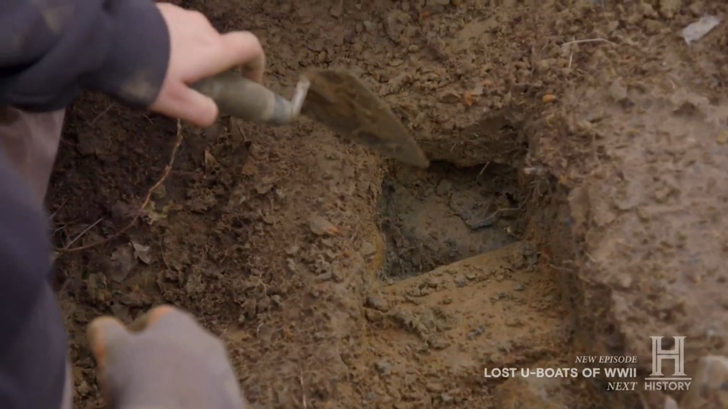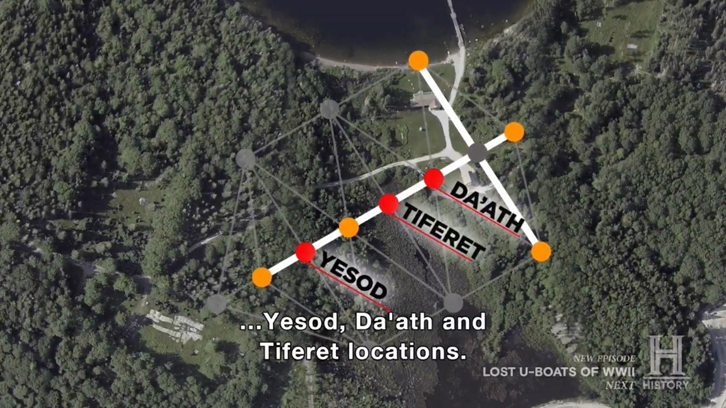SEASON 11, EPISODE 20, “WET AND WILD” ARTIFACT AND FEATURE ANALYSIS
- Daniel Spino

- Mar 27, 2024
- 6 min read
The Curse of Oak Island – The History Channel
In this week’s episode, “Wet and Wild”, we are first taken to the frequently visited site at the southeastern corner of The Swamp, where the excavation work continues. The site appears to be a ship’s wharf where loading and unloading of cargo took place. After deeper excavation, it appears that there is a layer of rocks that looks like they been covered. The team says it appears to be a road that went to The Swamp. It is mentioned that in the 1930’s, an aerial photo shows what appears to be a stone road/pathway near the Money Pit. It was mentioned that it was destroyed in the 1960’s by Robert Dunfield’s work on the Island.
ANALYSIS
In Rupert Furneaux’s, “The Money Pit Mystery” 1972, he writes the following, “None of these (Early Oak Island) landowners seem to have lived on the island or to have cultivated the ground. A road ran down the the centre of the main part of the island, from west to east, which divided lots 1-14 on the north side from lots 21-32 on the south side. It may have been construction at the time of the survey (1785) or it may have existed prior to 1785.”
Furneaux then writes, "He (Colin Summers) also told me he had discovered that the ‘road’, observed in 1795, disappeared and ran beneath the swamp on the southern shore. Its continuation on the other side would have brought it directly to the stone triangle which was found in 1937. This suggests that the road had been constructed before the swamp encroached, possibly before 1785, when the road was employed as a boundary between lots…”.
This brings up the question, is the stone road really from 1200AD or was it made as a lot divider much later? It’s hard to imagine that a series of roads across the island would have been made for the purpose of covertly burying treasure.
The Curse of Oak Island – The History Channel
We then move to the New Lab where Blacksmith Carmen Legge is visiting the Oak Island team to give his opinion on two recently found artifacts. Carmen inspected the first piece and immediately seemed to know what it was. He said it is a Backing Bolt that was used on the Yoke for a team of Oxen. Considering Carmen is an expert in this area, he was extremely confident in his opinion. He mentioned that the date could have been from the 1600’s to no later than the 1760. He also said the piece is French in origin. The next artifact gave Carmen a little more difficulty. He mentioned it was about 14 inches long but wasn’t quite sure about it and asked Archeometallurgist, Emma Culligan for some more information on its composition. She said that she couldn’t fit the entire piece in the XRF scanner so she could only do a portion of it. Emma mentioned that the piece had a high manganese level and was not modern. She estimated that the piece would have been from the early 1700’s or earlier. She said that based on its composition it seemed Swedish in origin. Carmen surmises it was a heavy wharf pin and the team agrees that some sort of operation was going on at the location of the discovery.
ANALYSIS
"History of the County of Lunenburg" by Judge Mather Byles DesBrisay
In “History of the County of Lunenburg”, by Judge DesBrisay, he writes, “On July 30th, 1756, Captain John Steignfort, with fifty armed men, went from Lunenburg to the Basin of Minas, and drove away 120 head of horned cattle and a number of horses, being part of the confiscated property of the French Acadians. The party returned to Lunenburg, September 3rd, with sixty oxen and cows, the rest having perished on the way-all the horses included.”
Could some of these oxen, that were taken from the French Acadians, have been used for some sort of operation involving heavy loads on Oak Island that would explain this French yoke being found?
The Curse of Oak Island – The History Channel
The scene shifted to the Lot 5 excavation site near the shore, where the Oak Island Archaeologists were working with Jack Begley. As Jack was sifting the team’s spoils, Archeologist Moya MacDonald, made an interesting discovery. As she dug into the dirt, she noticed something blue. Upon further investigation she realized that it was blue clay. Archeologist Helen Sheldon mentioned that it was not something that they have found on this part of the island and the team agreed it was most likely from the Money Pit. Earlier, the team found evidence that there was other material from the Money Pit area that was found on Lot 5. It should be noted that blue clay has previously been found by the Oak Island team in quantity at the Eye of The Swamp.
The Curse of Oak Island – The History Channel
We are then taken to the War Room, where the Oak Island team met with researcher John Edwards. Edwards appeared last week on the show and said he would be able to give precise locations for finding possible treasure on the island if he was granted access to the Nolan’s Cross area. Tom Nolan granted him access and Edwards presented the results. Edwards stated that the way to find the treasure is built into Nolan’s Cross itself. He mentioned he worked with surveyor, Steve Guptill, to make measurements of the cross. Based on these measurements of 144’, 720’, and 864’, he said they were all divisible by 72. He feels that 72 is the key to figuring out who built the cross and he thinks it was the Knights Templar. Edwards cites the Latin Rule as evidence of Templar involvement. The Latin rule consisted of 72 clauses that detailed the ideal behavior of a knight. Edwards went on to suggest that in his opinion that treasure could be found at either Da’ath, Teferet, or Yesod that comprises the Tree of Life symbol that is made from Nolan’s Cross.
ANALYSIS
Cracking the Shakespeare Code by Petter Amundsen
The Compendium feels it is extremely convenient that Edwards gave the search locations of Da’ath, Teferet, or Yesod to find possible treasure, when those points are the ones that have never been searched by Petter Amundsen, the originator of this theory, and the Oak Island team. The measurements that were taken are the same measurements that have been used by other Oak Island researchers. These include Petter Amundsen, the late Chris Donah, Christopher Morford, Brian Pharoah, and others. The difference being the interpretation of the number 72. Oddly, Edwards attributes this number to the Templars when his previous research clearly points to another source. Perhaps this source was mentioned and cut form the show, the Compendium acknowledges that possibility. Although these other possible sources for the number 72 should be noted.
72 is the base of sacred numbers. 72 is the gematria value for the Mercy Point that Petter Amundsen associated with Sir Francis Bacon and the Rosicrucians. In numerology, the number 72 represents transformation and enlightenment. This number is coded in the Jewish and Christian Bibles, the Fibonacci sequence, the works of Shakespeare, and in many other sources. In what appears to be another case of convenience, the citing of the Knights Templar handbook as evidence of who built Nolan’s Cross seems extremely narrow and insufficient considering all these other possibilities.
The Curse of Oak Island – The History Channel
The action shifted to the north portion of The Swamp where the Oak Island team is beginning an excavation at the proposed “TEFERET” location of the Tree of Life. This was first suggested by researcher Petter Amundsen, that is now being put forth by John Edwards. After some digging it is mentioned that the area is very rocky. A large boulder is found that appears to have been unnaturally placed at the location. The team believes this may be the “TEFERET” spot and the team plans to explore the area more extensively to see if anything is buried underneath the stone.
The Curse of Oak Island – The History Channel
Our analysis concludes at the War Room, where the Oak Island team is meeting to discuss the Copper Sheeting that was found last year on Lot 8. A conservator in Canada was able to unfold the piece very delicately. The piece seems to have been decorative and made of copper that was not local. It appears to be hand designed and made by the Press Block technique of working metal that goes back a thousand years. It appears this piece could be Anglo Saxon, Western or Northern European in origin. Oak Island Historian Doug Crowell showed two examples of the pattern on the piece that could indicate an Icelandic/Norse origin, or a French European origin. The Icelandic/Norse piece is rune related to Astronomy/Astrology and the French European piece is a quadrant of an Astrolabe dating to the late 1200’s to early 1300’s. Both examples suggest some ancient navigational symbols. Doug states the information will be sent to Professor Gaspani for his opinion on both pieces. The Compendium will also be investigating the source of the folded copper. Until next week.
Good day from the Compendium!

























